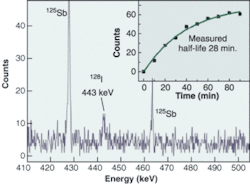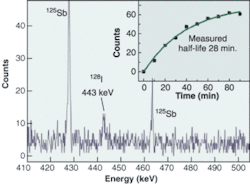Tabletop laser induces transmutation
Researchers at the University of Jena (Jena, Germany) and the Institute of Transuranium Elements (Karlsruhe, Germany) have succeeded in using a tabletop laser to bring about the gamma-ray-induced nuclear reaction that transmutes the long-lived radioactive isotope iodine-129 to the short-lived iodine-128.1 Iodine-129 is one of the key isotopes generated in nuclear fission (see "Large laser tackles nuclear-waste problem," this page).
All the equipment in the Jena laser setup fits on a 15-m2 optical table. Despite few transmuted nuclei per laser shot so far, the experiment showed that laser-driven nuclear reactions can be studied even in a university-scale laboratory, meaning that research on this topic is no longer dependent on massive machinery such as reactors or large-scale laser plants.
The Ti:sapphire laser light source in the Jena experiment emits 1-J pulses at an 800-nm center wavelength with 80-fs pulse duration and 10-Hz repetition rate. It produces a peak power in the multi-terawatt range that, when focused to a 5-µm2 spot on a tantalum target, reaches a power density of up to 1020 W/cm2.
An iodine sample containing 17% iodine-129 in the form of lead iodide was placed behind a 2-mm-thick tantalum sheet and the target irradiated with 10,000 laser shots. Gamma rays were generated by the acceleration of plasma electrons to relativistic energies by the laser field and subsequent deceleration in the target, which releases bremsstrahlung radiation.
After irradiation, gamma spectra were taken in the range from 410 to 480 keV in successive time intervals. A gamma peak belonging to the beta decay of iodine-128 to xenon-128 could be detected at 443 keV (see figure). This decay channel produces 93% of the iodine-128 disintegration, with the rest occurring via electron capture into tellurium-128. Xenon-128 is a stable isotope. The iodine-128 half-life was determined to be 28 ± 5 min, in good agreement with the tabulated value of 25 min. Using calibrated germanium detectors, the authors calculated the number of gamma-ray-induced nuclear reactions to be two per laser shot.
Because energetic particles other than electrons are ejected from the plasma, the study of different nuclear reactions is now possible using tabletop lasers. The development of more-efficient tabletop lasers will extend studies of laser-induced nuclear reactions; such investigations may help in finding a solution to the problem of radioactive nuclear waste.
REFERENCE
- Ultrafast Optics IV Conf., Vienna, (June 29, 2003); J. Magill et al., Appl. Phys. B (2003), DOI: 10.1007/s00340-003-1306-4.

